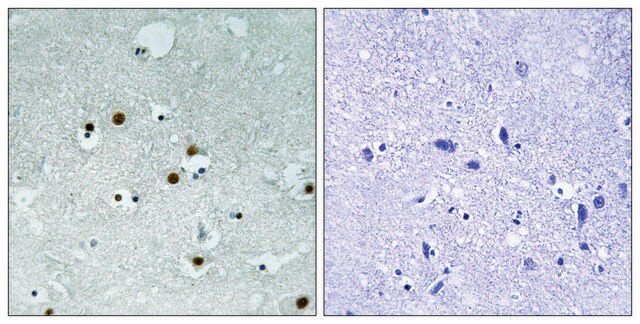05-689
Anti-HP1α Antibody, clone15.19s2
clone 15.19s2, Upstate®, from mouse
Sinónimos:
Antigen p25, HP1 alpha, HP1Hs alpha, Heterochromatin protein 1 homolog alpha, chromobox homolog 5 (Drosophila HP1 alpha), chromobox homolog 5 (HP1 alpha homolog, Drosophila), heterochromatin protein 1-alpha
About This Item
Productos recomendados
origen biológico
mouse
Nivel de calidad
forma del anticuerpo
purified immunoglobulin
tipo de anticuerpo
primary antibodies
clon
15.19s2, monoclonal
reactividad de especies
mouse, vertebrates, human
fabricante / nombre comercial
Upstate®
técnicas
ChIP: suitable
immunocytochemistry: suitable
immunohistochemistry: suitable
immunoprecipitation (IP): suitable
western blot: suitable
isotipo
IgG1
Nº de acceso NCBI
Nº de acceso UniProt
Condiciones de envío
wet ice
modificación del objetivo postraduccional
unmodified
Información sobre el gen
human ... CBX5(23468)
Descripción general
Especificidad
Inmunógeno
Aplicación
A previous lot of this antibody has been reported by an independent laboratory to detect HP1a in NIH/3T3 nuclei (Ayyanathan, K., 2003).
Immunoprecipitation/Chromatin Immunoprecipitation:
A previous lot of this antibody has been reported by an independent laboratory to immunoprecipitate HP1α from nuclear extracts and formalin-cross-linked chromatin (Ayyanathan, K., 2003).
Epigenetics & Nuclear Function
Chromatin Biology
RNA Binding Protein (RBP)
Calidad
Western Blot Analysis:
0.5-2 µg/mL of this lot detected HP1α protein in acid-extracted HeLa cell lysates.
Descripción de destino
Ligadura / enlace
Forma física
Almacenamiento y estabilidad
Handling Recommendations:
Upon receipt, and prior to removing the cap, centrifuge the vial and gently mix the solution. Aliquot into microcentrifuge tubes and store at -20°C. Avoid repeated freeze/thaw cycles, which may damage IgG and affect product performance.
Nota de análisis
HeLa, NIH/3T3 and COS cell lysates.
Otras notas
Información legal
Cláusula de descargo de responsabilidad
¿No encuentra el producto adecuado?
Pruebe nuestro Herramienta de selección de productos.
Código de clase de almacenamiento
12 - Non Combustible Liquids
Clase de riesgo para el agua (WGK)
WGK 1
Punto de inflamabilidad (°F)
Not applicable
Punto de inflamabilidad (°C)
Not applicable
Certificados de análisis (COA)
Busque Certificados de análisis (COA) introduciendo el número de lote del producto. Los números de lote se encuentran en la etiqueta del producto después de las palabras «Lot» o «Batch»
¿Ya tiene este producto?
Encuentre la documentación para los productos que ha comprado recientemente en la Biblioteca de documentos.
Nuestro equipo de científicos tiene experiencia en todas las áreas de investigación: Ciencias de la vida, Ciencia de los materiales, Síntesis química, Cromatografía, Analítica y muchas otras.
Póngase en contacto con el Servicio técnico








